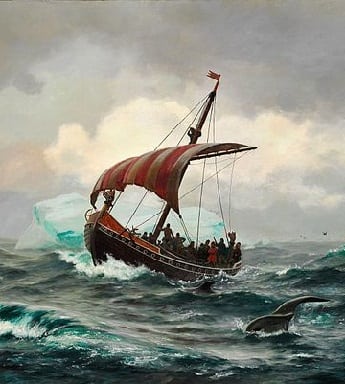Click here for a great selection of Amazon.com books about the Vikings discovery of America.
Viking Discovery of America Introduction
On this page we provide information on how the Vikings were able to make such an incredible journey, where in North America they landed and why they did not form any permanent settlements. The Vikings discovered America most likely by accident. According to the Icelandic sagas, in 985 AD a Viking fleet lead by a merchant named Bjarni Herjolfsson was blown off course while sailing from Iceland to Greenland. A few days later they spotted the North American coastline. Bjarni was not interested in exploring the new land and promptly sailed back to Greenland. Back in Greenland Bjarni informed his fellow Vikings, including Leif Ericson, of the new land he had spotted.Viking Discovery of America - Leif Ericson
Fifteen years after Bjarni Herjolfsson spotted America the famous Viking Leif Ericsson headed out from Greenland to explore the new world. With a crew of thirty five Leif made the 1,800 mile voyage to the new world. He and his crew explored the new world and establish a small settlement there. He discovered and explored three separate areas during his exploration of the North American continent. These areas are listed below.- Helluland - Translates to "land of the flat stones"
- Markland - Translates to "land of forests". Since Greenland had very few trees, this area was an important discovery for Leif. It is believed the Vikings made many voyages to North America in order to obtain lumber.
- Vinland - It is here that the first Viking settlement was built. There is a debate as to the translation of the word Vinland. Some believe it to be "the land of wine", others believe it means "the land of meadows".
Viking Discovery of America - Other Viking Expeditions
In 1004 AD Leif's brother Thorvald, with a crew of thirty, sailed to Newfoundland and spent the winter at the camp Leif had created. Hostilities broke out between the Viking settlers and the Native American Indians. Thorvald was killed by an arrow when his camp was attacked by a war party seeking revenge for an earlier attack. Leif's other brother Thorstein sailed to the new world in order to bring back their brother Thorvald's body; he only stayed for one summer.
Another documented Viking journey to America is that of Thorfinn Karlsefni (Thorfinn the Valiant). He sailed to North America with three ships and at least 160 settlers sometime between 1004 and 1010 AD. He found and expanded Leif Ericson's camp. Eventually hostilities with the native North Americans drove Thorfinn and his fellow settlers back to Greenland.
Viking Discovery of America - Conclusion
Even though the Vikings discovered America it appears that they never established a permanent settlement there. All archaeological evidence and historical data indicates that only temporary camps were set up. The reason for this is not known for sure but could have to do with hostilities with the native North Americans.
It is believed that for centuries after Leif Ericson's voyage to the new world Vikings made periodic voyages to the new world. These trips were most likely to obtain lumber which was in short supply in Greenland. There have been several controversial discoveries that are believed by some to be evidence of these continued Norse voyages to the new world. The discovery of a Norwegian silver penny called "The Maine Penny" (also referred to as the Goddard coin) dating to King Olaf Kyrre's reign, from 1067 AD to 1093 AD, was supposedly discovered in a Native American archaeological site in Maine in 1957. This obviously indicates contact between the North American natives and the Norse in the late 11th century or after. Further possible evidence of the continued voyages of the Vikings to North America is the discovery of several Rune stones; which many people believe to be hoaxes. The most famous of these is the Kensington Runestone found by a farmer in Minnesota in 1898 and dated 1362.
